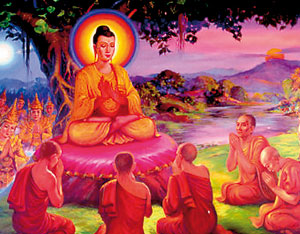After attaining enlightenment at Buddha Gaya on a Vesak Poya Day (in May) 2600 years ago, Sakyamuni Gotama Buddha had thought to himself whether there were no people alive, who could comprehend his profound Dharma which he said, was deep, difficult to see and difficult to understand, tranquil, excellent beyond dialectic, subtle and intelligible only to the learned. Deva, Brahma Sampathi in Heaven had then addressed the All Knowing Perfect One and said, there were few on earth “with little dust in their eyes”. He said:
“Rise O conqueror of war of miseries, leader of man,
free from all impurities; wander forth in this world,
O Bhagavan, preach your teaching, there will be persons who will comprehend:"
Gotama Buddha then surveyed with clairvoyancy (His Divine Eyes) where the virtuous and intelligent lived, and thought of his five fellow ascetics, who then resided at the Deer Park, in Isipathana (modern Saranath (Varnasi) close to Benares. He said, “In the language of angels, of serpents or even fairies if there be, in the speech of demons, the talk of humans, in them I shall expound my Dharma, deep as it be, and in the tongue they may grasp.”
 |
So saying, He went to Isipathana and met the five ascetic friends, Kondanja, Baddiya, Assaji, Mahanama and Vappa to deliver without reservation his historic first sermon, the Dhamma Chakkupavana Sutta. On that historic Esala Poya Day, in July, the Buddha preaching the historic sermon to set in motion with kindness and compassion for humanity, “the Righteous Wheel of Buddhism” as opposed to the known wheel of a chariot used by a warrior who goes to war, with greed for power and land, and have bloodstained hands. This then, was an important communication of the Buddha, heard at Sarnath, and opened the ears of the world to learn of the noble Dharma.
Whilst all theistic religions refer to a creator God, who guides man’s destiny and forgives him for his sins, the Buddha who had gained enlightenment at Gaya, was concerned with only on one thing; the way to end all forms of suffering on earth. Addressing the five ascetics at Sarnath on a Esala Full Moon Day in July he said:
“This O monks is the noble truth of suffering. Birth is suffering, pain of mind and body is suffering, illness is suffering, association with the unpleasant (people) is suffering, loss of wealth and disassociation with the beloved is suffering; when one does not receive what is desired is suffering, old age and death is suffering; in short, the five fold clinging to craving, attachment is suffering.”
Suffering, the Buddha said, is the first of the four Noble Truths. He went further in his sermon and spoke of its cause, its end and the way to its end.
He then explained to his new found disciples at Sarnath, to give up the two extremes of livings. That is enjoyment of sensual pleasures and the tormenting of one’s body (self indulgence and self mortification). Finally, the Buddha advocated living the Middle Path (Majjhima Patipada) by following the Noble Eightfold Path which can help man to arrive at Nibbana.
The Buddha referred to Samma Ditti (Right understanding), Samma Samkappa (Right thoughts), Samma Vacha (Right speech), Samma Kammantha (Right action), Samma Ajiva (Right livelihood), Samma Vayama (Right effort), Samma Sati (Right mindfulness), Samma Samadhi (Right concentration). Those who follow the Noble Eightfold Path will be free from clinging or attachment and craving which is the root of suffering.
The Buddha showed the way to end suffering on earth.
Anagarika Dharmapala and the
beginnings of the Maha Bodhi Society
The historic first sermon delivered at the Deer Park, Sarnath to five ascetics by Gotama Buddha, took place 2600 years ago. This was a landmark event in the history of Buddhism. Six months later, the first missionaries of the world set out from Sarnath to preach the noble Dharma. Don David Hewavitarne of Matara (born in 1864) was in self-exile for more than 33 years at Sarnath leading a religious life, taking the name of Anagarika Dharmapala. Later, he became the Ven. Devamitta Thera.
This patriotic son of Lanka was a fearless preacher and championed several Buddhist causes in Sri Lanka, along with his friend Walisinghe Harischandra, a Buddhist nationalist leader. Dharmapala is best known for having spearheaded the movement to wrest the hallowed Buddha Gaya Temple from the hands of a Hindu Mahantha. To achieve this, being a pacifist, he fought relentlessly in the Civil Courts of Bihar and Calcutta for a number of years.
In 1893 Anagarika Dharmapala addressed the Congress of Religions in Chicago and later appealed for funds from Ceylonese, Burmese and Japanese Buddhists to build the beautiful Mulagandhi Kuta Vihare, at Sarnath. By his side, for many years, was Ven. Metiwela Sangharatana Maha Thera, who did much to maintain the hallowed site. The two of them together developed Isipathana, the Deer garden where the Buddha preached the first sermon.
The Anagarika Dharmapala was responsible for establishing the Maha Bodhi Society of India, with its headquarters at Calcutta. He passed away in 1933 at Sarnath. - U.K.S. |


